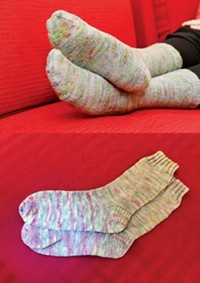Advertisement
Grab your lab coat. Let's get started
Welcome!
Welcome!
Create an account below to get 6 C&EN articles per month, receive newsletters and more - all free.
It seems this is your first time logging in online. Please enter the following information to continue.
As an ACS member you automatically get access to this site. All we need is few more details to create your reading experience.
Not you? Sign in with a different account.
Not you? Sign in with a different account.
ERROR 1
ERROR 1
ERROR 2
ERROR 2
ERROR 2
ERROR 2
ERROR 2
Password and Confirm password must match.
If you have an ACS member number, please enter it here so we can link this account to your membership. (optional)
ERROR 2
ACS values your privacy. By submitting your information, you are gaining access to C&EN and subscribing to our weekly newsletter. We use the information you provide to make your reading experience better, and we will never sell your data to third party members.
Climate Change
Newscripts
Knit climate data, and a wearable periodic table
by Gina Vitale
April 9, 2021
| A version of this story appeared in
Volume 99, Issue 13
Crafting for climate

In early 2017, at the beginning of Donald J. Trump’s presidency, Emily McNeil, Justin Connelly, and Marissa Connelly were among many concerned about information on climate change being scrubbed from US government websites. They started to discuss ways of recording climate data in more physical, permanent ways. It wasn’t long before knitting entered the talks.
People have been knitting temperature blankets for years—take a given city, assign a yarn color to each temperature or temperature range, and knit one row of the appropriate color for each day’s high, low, or average temperature. It’s a colorful way to visualize the seasons in a given area or a crafty way to remember what the year’s weather was like. Or, the trio thought, a way to show in brilliant color how rapidly the world is warming.
The group started a local project in which volunteer knitters around Anacortes, Washington, created tapestries out of temperature data. They used daily high temperatures and a standardized color system, with the coldest ranges corresponding to blues, purples, and black, and the warmest ones, reds and oranges. They called it the Tempestry Project—a portmanteau of temperature and tapestry. When McNeil started hearing their invented word in other circles, she realized just how large their movement had grown. “Clearly it was connected to them hearing about our work in one way or another, sort of like Xerox instead of copiers,” McNeil tells Newscripts.
It wasn’t long before interested knitters were asking for yarn kits to make their own tapestries. Justin prepares the kits by pulling data from the location of interest and gathering the colors and amounts of yarn to sell to each crafter. They’ve since processed Tempestry kits for knitters in all 50 states, in 30–40 countries, and on every continent. Tempestries have also been featured in art installations around the US.
The knitters have started selling another type of tapestry kit, called the New Normal, inspired by University of Reading professor and climate scientist Ed Hawkins’s warming-stripes data visualization. In these kits, rather than each colored row representing the high temperature for 1 day, each row represents the deviation in 1 year from the baseline, which is averaged from 1951 to 1980. The resulting pattern shows how quickly that deviation has grown.
Interested knitters can find the kits at tempestryproject.com. A portion of proceeds from certain kits are donated to various nonprofits, many of which are climate related.
Periodic fashion

Andrew Bergeron, a chemist at Canadian Nuclear Laboratories, knew he had the chemistry knowledge to be a panelist on “Element of Surprise,” a weekly segment on a Canadian public radio show that takes listeners on a deep dive into the history and science of a chosen element. But to really impress the radio show, he sent in a photo of himself in a stylish black cardigan—which happened to feature the entire periodic table of the elements.
Andrew’s wife, Rebecca Bergeron, knit the chemical cardigan, which garnered lots of attention after @cbcallinaday, the show’s Twitter account, posted the photos of Andrew proudly sporting it.
After nearly 12 years together, Andrew has a stack of lovingly knit apparel from Rebecca. “I just decided that every couple of years he should get a sweater,” Rebecca says.
The recent 150th anniversary of the periodic table, along with the extra time stuck inside provided by the COVID-19 pandemic, inspired Rebecca to take on the ambitious design of the periodic table sweater. She finished it in April 2020, and Andrew has been using it to spark jealousy in his coworkers ever since.
“I wear it all the time,” he tells Newscripts. “Any opportunity I get.”
Advertisement
Please send comments and suggestions to newscripts@acs.org.





Join the conversation
Contact the reporter
Submit a Letter to the Editor for publication
Engage with us on Twitter